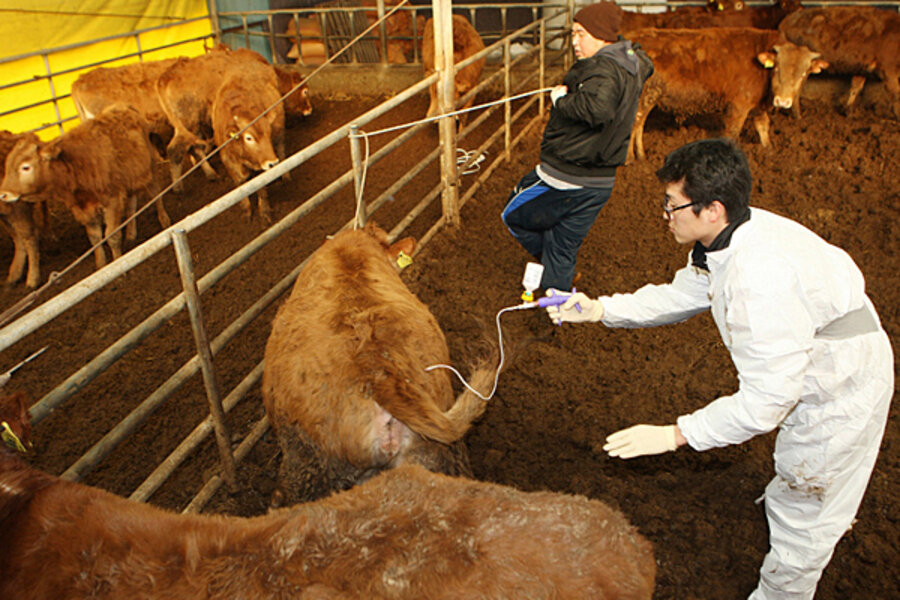South Korean farmers assess fallout of major outbreak of foot and mouth disease
Loading...
| Pocheon, South Korea
Just over a year ago, Lim Eun-hee saw her husband's pig farm in this rural region northeast of Seoul decimated in one fell swoop.
Though there were no cases of foot and mouth disease detected on their land, she says, a nearby cow farm reported an infected animal and that meant their entire herd, too, had to be culled. “I wanted to cry because my husband was so hurt” by the news, says Ms. Lim. “You go to the farm, and there is nothing – the sounds of the pigs, gone."
Then, when the disease returned three months ago, the family was prepared, having inoculated its slowly repopulated livestock. But around them in the Pocheon region, colleagues and friends in the livestock industry have been poleaxed in South Korea’s worst outbreak of foot and mouth.
The outbreak, which affects cloven-hoofed animals, has plunged the South Korean farming sector into crisis mode, threatening the livelihoods of a generation of farmers – many of whom face the realistic prospect of losing their businesses – and hitting consumers in the pocket by forcing food price increases.
The country has already culled 3.33 million animals – including pigs, cattle, goats, and deer – according to a recent estimate. At 165 farms in Pocheon area alone, only about a fifth of an original 260,000 pigs remain, according to a representative of the local pig association. Foot and mouth is now also sweeping North Korea, threatening to deepen an already dire food situation there, according to Radio Free Asia. As the losses mount and countries around the world worry about a spread beyond the peninsula, Seoul is coming under increasing pressure to stem the spread.
But a sliver of hope has emerged. The state-run National Veterinary Research and Quarantine Service said Monday that tests at 15 sites where culled livestock are buried showed no signs of contaminated run-off. And last week, one official said the outbreak was on the slide as a vaccination program begins to take hold.
Financial ruin
For those living amid the battle to combat the spread of the disease, the emotional and financial impact has been heavy, with the total economic cost estimated up to $1.75 billion.
And the government’s financial salvo for afflicted farmers may not be enough to stop them from going bust. “There are many cow farmers here,” says Jang Suk-won, of the Pocheon Community Center. “They are suffering, and in some cases cannot even scrape by.”
The lengthy rearing process, says Mr. Jang, compounds the problems the farmers face: After receiving compensation – the government pays the market value of animals lost – many will barely be able to repay start-up loans. “It takes three years to get going,” he explains. “So when they lost all these cows and pigs and when they repay the debt to the banks, they have nothing.”
Battle scars
Last week one cow farmer was reportedly found dead in an apparent suicide, a day after he found out that one of his animals was infected. Lee Myung-gu, a farmer in Pocheon, has sought help to cope with the loss of his animals. “I was not grieving this much even when my parents passed away,” he says, indicating an impending economic shortfall seem almost secondary.
Other affected farmers refuse to even speak to the press, fearing the stigma attached to their farms.
In the downtown area of the city of Pocheon, signs of the battle are visible outside public buildings in the form of foot trays for the decontamination of shoes. Cars are routinely sprayed down.
Government structure?
Many still blame the government’s initial’s response to the outbreak in late November: One burial site containing 9,000 animals in the Pocheon area is just minutes from a school, according to a local report. Others are said to be in desperate need of reinforcement – possibly with the digging of new ditches lined with concrete to prevent seepage.
International animal rights activists have condemned initial efforts to combat the spread, which saw some livestock buried alive amid vaccination shortages.
Elsewhere, food prices have taken a hit. Pork prices spiked 12 percent in January and tariffs on more pork and powdered milk imports have been slashed.
Jang of the local community center says a lack of procedural structure in regions like his, where there are many small farms, could have exacerbated the problem. Pocheon's mountainous geography further complicated government-led efforts to eradicate the disease, he says, even while neighboring farming regions have been given the all-clear.
"My friend owns cows on Geoje Island, and his farm has very good management skills but because the city here is not systematically efficient, a lot of damage has been done," he says. "So I think the government should [model itself after that kind of system] in order not to let this happen again."





